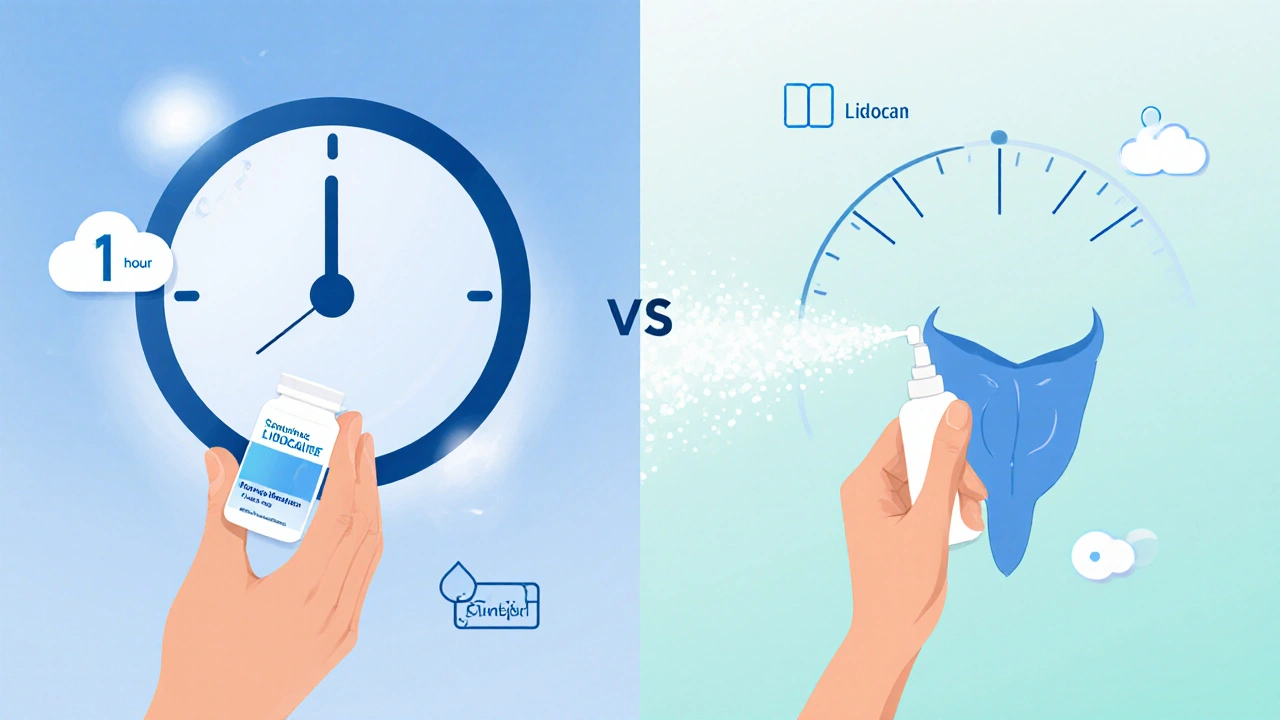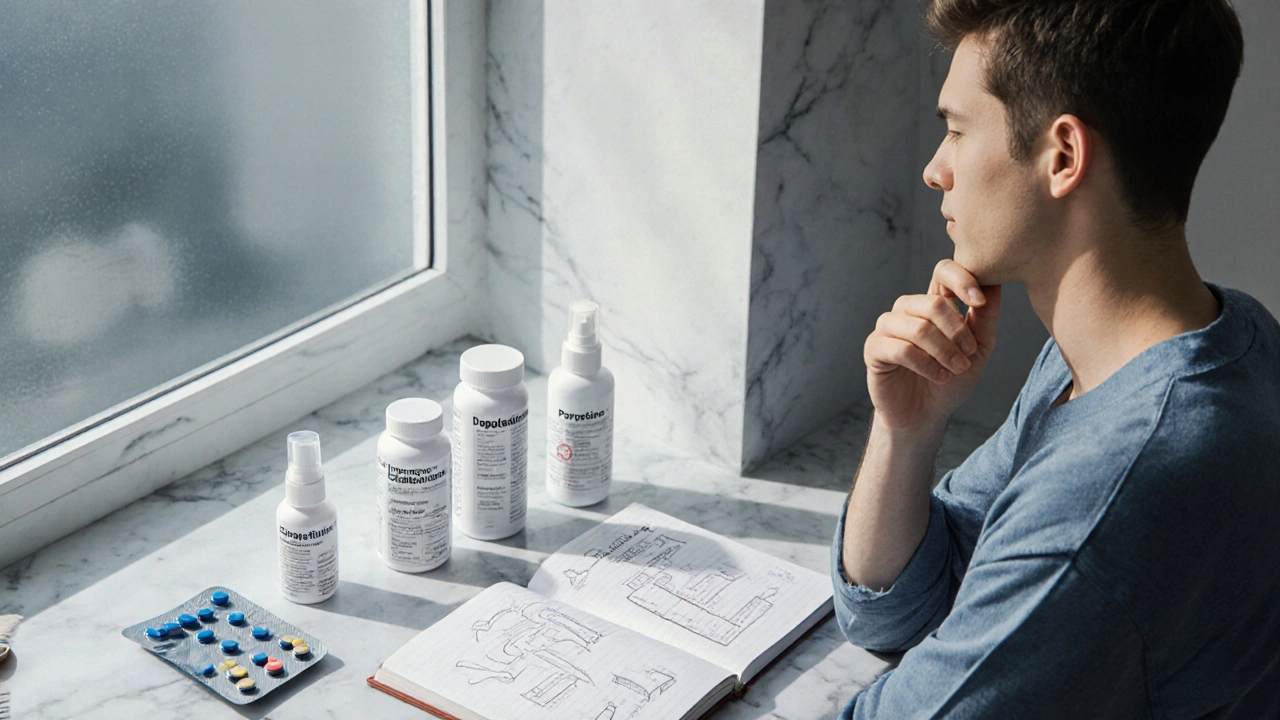Premature Ejaculation Treatment Selector
Recommended Treatment Options
Why This Recommendation?
Key Takeaways
- Dapoxetine is the only drug approved specifically for premature ejaculation (PE), offering fast onset but limited to short‑term use.
- Off‑label SSRIs like paroxetine and sertraline work well for many men but require daily dosing and have broader side‑effect profiles.
- Topical anesthetics (e.g., lidocaine spray) provide on‑demand control with minimal systemic effects, though they can reduce sensation for both partners.
- PDE5 inhibitors (sildenafil, tadalafil) help when PE co‑exists with erectile dysfunction, but they don’t directly delay ejaculation.
- Behavioral techniques remain essential and can boost the success of any pharmacologic option.
When it comes to treating premature ejaculation, you’ve probably heard the name Dapoxetine is a short‑acting selective serotonin reuptake inhibitor (SSRI) that the European Medicines Agency approved specifically for PE in 2009. It’s taken a few hours before sex, peaks in the bloodstream within 1-2hours, and can extend intravaginal ejaculatory latency time (IELT) by 2‑3minutes on average. But is it the best choice for you? This article lines up dapoxetine against the most common alternatives, so you can see which one fits your lifestyle, health profile, and relationship needs.
How Dapoxetine Stacks Up
First, let’s break down the core attributes of dapoxetine itself:
- Drug class: Short‑acting SSRI
- Approved indication: Premature ejaculation (PE)
- Typical dose: 30mg or 60mg taken 1‑3hours before intercourse
- Onset of action: 1-2hours
- Duration: About 6hours; designed for occasional use
- Common side effects: Nausea, headache, dizziness, rare sexual dysfunction
- Prescription status: Prescription‑only in the UK, EU, Australia
Because it’s short‑acting, dapoxetine avoids the accumulation issues that plague daily SSRIs, but you still need a doctor’s prescription and a short planning window before intimacy.
Off‑Label SSRIs: Paroxetine, Sertraline, and Clomipramine
Many men turn to other SSRIs that aren’t licensed for PE but have shown solid results in clinical trials. Here’s a quick snapshot of the three heavyweights:
- Paroxetine - a long‑acting SSRI usually dosed 10‑20mg daily. It can increase IELT by 3‑4minutes but may cause fatigue or decreased libido.
- Sertraline - another daily SSRI, 50‑100mg per day. Offers a gradual improvement, often used when patients also need anxiety relief.
- Clomipramine - a tricyclic antidepressant, 25‑50mg daily. Powerful for PE but brings anticholinergic side effects like dry mouth.
All three require continuous use, meaning you’re committing to a medication every day, not just before sex. That can be a plus for men who want consistent results, but the systemic side‑effects are broader than dapoxetine’s short‑term profile.
Topical Anesthetics: Lidocaine Spray and Cream
If you’d rather avoid pills, a topical anesthetic could be the answer. The most common option is Lidocaine spray, applied directly to the penis 5‑15minutes before intercourse. It numbs the skin enough to delay ejaculation, usually extending IELT by 2‑5minutes.
- Advantages: No systemic absorption, works on demand, inexpensive over‑the‑counter in many countries.
- Drawbacks: Can dull sensation for both partners, may cause mild irritation, and effectiveness varies with proper application.
Topical creams (e.g., lidocaine‑prilocaine mixtures) work similarly but require a longer waiting period (about 20‑30minutes) and can be messier.

PDE5 Inhibitors: Sildenafil and Tadalafil
While not designed to treat PE directly, PDE5 inhibitors like sildenafil (Viagra) and tadalafil (Cialis) can help men whose premature ejaculation coincides with erectile dysfunction (ED). By improving erection rigidity and confidence, these drugs indirectly allow men to last longer.
- Typical dose: Sildenafil 25‑100mg taken 30‑60minutes before sex; tadalafil 10‑20mg taken at least 30minutes before, with a longer window up to 36hours.
- Side effects: Headache, flushing, nasal congestion.
- Limitations: No proven increase in IELT when used alone for PE.
For many, a combined approach-PDE5 inhibitor for erection plus a PE‑focused option-delivers the best overall sexual experience.
Behavioral Techniques and Therapy
The condition premature ejaculation isn’t purely physiological; anxiety, relationship dynamics, and learned habits play big roles. Classic behavioral methods include:
- Stop‑start technique: Pause stimulation before climax, then resume after the urge subsides.
- Squeeze technique: Apply pressure to the penile head to reduce arousal momentarily.
- Pelvic floor exercises (Kegels): Strengthen the muscles that control ejaculation.
When paired with any medication, these methods can boost efficacy by up to 30%. A few sessions with a sexual therapist often make a noticeable difference.
Comparison Table
| Option | Class | Typical Dose | Onset | IELT Increase | Side Effects | Prescription? |
|---|---|---|---|---|---|---|
| Dapoxetine | Short‑acting SSRI | 30‑60mg 1‑3hrs before sex | 1-2hrs | +2‑3min (avg.) | Nausea, headache, dizziness | Yes |
| Paroxetine | Long‑acting SSRI | 10‑20mg daily | Several days (steady state) | +3‑4min | Fatigue, sexual dysfunction | Yes |
| Sertraline | Long‑acting SSRI | 50‑100mg daily | Several days | +3‑5min | Nausea, insomnia | Yes |
| Clomipramine | Tricyclic antidepressant | 25‑50mg daily | Several days | +4‑6min | Dry mouth, constipation | Yes |
| Lidocaine spray | Topical anesthetic | Apply 5‑15min before | 5‑15min | +2‑5min | Reduced sensation, irritation | No (OTC) |
| PDE5 inhibitor (e.g., Sildenafil) | Phosphodiesterase‑5 inhibitor | 25‑100mg 30‑60min before | 30‑60min | Variable (indirect) | Headache, flushing | Yes (prescription in UK) |
| Behavioral therapy | Non‑pharmacologic | Practice sessions, therapist visits | Immediate (technique‑based) | +2‑6min (when combined) | None | No |
Choosing the Right Option for You
Here’s a quick decision guide:
- Need on‑demand control and have a prescription routine? Dapoxetine fits perfectly.
- Prefer daily consistency and also need anxiety relief? Paroxetine or sertraline may serve a dual purpose.
- Want an OTC solution with minimal systemic impact? Lidocaine spray is the go‑to.
- Deal with both PE and erectile dysfunction? Pair a PDE5 inhibitor with any of the above.
- Concerned about medication side effects? Start with behavioral techniques; add a low‑dose SSRI if results plateau.
Always discuss with a GP or urologist before starting any prescription drug, especially if you’re on other medications or have chronic health conditions.

Common Pitfalls and How to Avoid Them
- Taking dapoxetine too late: If you wait less than an hour before sex, you might miss the peak effect.
- Skipping the “wash‑out” period: Switching from a daily SSRI to dapoxetine requires a 5‑day washout to prevent serotonin syndrome.
- Using too much lidocaine: Excess can cause numbness that dampens pleasure for both partners; follow the product’s dosage instructions.
- Ignoring partner feedback: PE is a shared experience-open communication improves adherence to any treatment plan.
Real‑World Example
Mark, a 38‑year‑old accountant from Manchester, tried dapoxetine once but found the timing tricky for spontaneous encounters. His doctor switched him to a low‑dose daily paroxetine, which gave a steady increase in IELT without planning ahead. After three months, Mark added pelvic floor exercises and reported a 60% improvement in satisfaction for both him and his partner.
Bottom Line
There’s no one‑size‑fits‑all answer. Dapoxetine shines when you need quick, prescription‑based control, but daily SSRIs, topical anesthetics, PDE5 inhibitors, and behavioral therapy each bring unique strengths. Weigh factors like dosing schedule, side‑effect tolerance, cost, and whether you also face erectile issues. A tailored mix-often starting with the least invasive option-delivers the most sustainable results.
Frequently Asked Questions
Can I take dapoxetine with other antidepressants?
Mixing dapoxetine with another SSRI, SNRI, or MAOI can trigger serotonin syndrome, a serious condition. Always follow a 5‑day wash‑out period when switching meds and consult your doctor.
Is lidocaine spray safe for regular use?
Yes, when applied as directed. Overuse can lead to chronic numbness or skin irritation. Rotate with other methods if you notice reduced pleasure.
Do PDE5 inhibitors really help with PE?
They don’t directly delay ejaculation, but improved erection firmness and confidence often translate to longer lasting intercourse, especially when combined with a PE‑focused drug.
How long does it take for daily SSRIs to work for PE?
Typically 2‑4 weeks to reach steady plasma levels. Some men notice subtle changes sooner, but full benefit usually appears after a month.
Can I use behavioral techniques without medication?
Absolutely. Many couples see a 30‑50% improvement with consistent practice of the stop‑start or squeeze methods, especially when combined with pelvic floor training.

Alfred Benton
October 10, 2025 AT 17:04It is a regrettable truth that modern pharmacology is increasingly infiltrated by corporate interests that prioritize profit over patient autonomy.
The narrative surrounding dapoxetine conveniently obscures the extensive body of evidence linking selective serotonin reuptake inhibitors to long‑term neurochemical alterations.
Moreover, the swift onset and brief duration of dapoxetine are presented as virtues, yet they conceal a hidden agenda of fostering dependency on prescription cycles.
One must also consider the covert lobbying efforts that have secured dapoxetine’s exclusive approval in Europe while marginalizing cheaper, equally effective alternatives.
The purported superiority of a “on‑demand” regimen subtly coerces men into a pattern of intermittent medicalization rather than encouraging sustainable behavioral strategies.
In contrast, the systematic review of off‑label SSRIs demonstrates comparable efficacy with a more favorable safety profile when administered under proper medical supervision.
Topical anesthetics, though dismissed by some clinicians, offer a non‑systemic approach that respects the principle of “do no harm.”
The omission of comprehensive cost‑benefit analyses in mainstream discourse betrays a selective presentation of data that benefits pharmaceutical stakeholders.
Furthermore, the discussion neglects the psychosocial dimensions of premature ejaculation, reducing a complex relational issue to a mere pharmacologic endpoint.
The emphasis on intravaginal ejaculatory latency time as the sole metric of success disregards patient‑reported satisfaction and partner experience.
Ethical prescribing demands that clinicians present the full spectrum of options, including behavioral therapy, before resorting to any medication.
The current regulatory framework, however, subtly incentivizes prescription of patented agents through reimbursement structures.
This creates a feedback loop in which clinicians, constrained by insurance formularies, feel compelled to adopt the marketed solution.
Patients, in turn, internalize the notion that pharmaceutical intervention is the inevitable cure for a condition that may also be mitigated by psychological insight.
A prudent approach would therefore integrate a stepped‑care model, beginning with low‑risk interventions and reserving dapoxetine for exceptional cases.
Until the medical community collectively rejects the commercial veneer and restores a patient‑centered dialogue, the promise of “the best treatment” will remain a mirage.
Susan Cobb
October 11, 2025 AT 06:57While many laud dapoxetine for its rapid action, a closer examination reveals that its benefits are narrowly defined and economically unsustainable for most consumers. In contrast, the evidence supporting lidocaine spray, albeit modest, underscores a cost‑effective, over‑the‑counter alternative that circumvents systemic exposure. Moreover, the longstanding clinical experience with daily SSRIs such as paroxetine and sertraline demonstrates durable latency improvements that cannot be dismissed as mere placebo effects. One must also acknowledge that behavioral techniques, when systematically applied, often rival pharmacologic outcomes without incurring any adverse events. Consequently, the portrayal of dapoxetine as the unequivocal champion appears more a product of marketing than of rigorous comparative analysis.
Ivy Himnika
October 11, 2025 AT 18:04While the data appear robust, a nuanced appraisal remains essential 😊.
Nicole Tillman
October 12, 2025 AT 10:44Premature ejaculation, as a biopsychosocial phenomenon, invites a multifaceted response that transcends the binary of drug versus no drug. The pharmacologic options discussed each occupy a distinct niche, yet none can claim universal supremacy. Dapoxetine offers on‑demand convenience, but its short half‑life limits applicability for couples seeking spontaneity. Conversely, daily SSRIs provide steady‑state relief at the cost of systemic exposure and potential mood effects. Topical anesthetics present a middle ground, though they demand meticulous application to avoid desensitization. Ultimately, integrating the chosen therapy with mindful communication and pelvic‑floor training creates a synergistic pathway to lasting satisfaction.
Sue Holten
October 12, 2025 AT 19:04Oh great, another pill that tells you to plan ahead like a wedding. Sure, nothing says romance like timing a medication.
Tammie Foote
October 13, 2025 AT 07:34Every treatment decision carries an ethical weight, especially when partners are involved. It's important to prioritize mutual consent and open dialogue. Skipping that conversation just to grab a quick fix feels irresponsible.
allen doroteo
October 13, 2025 AT 17:17Look, man, they push dapoxetine like it's the holy grail, but it's just another pharma gimmick.
People think a pill will fix everything, but they're blind to the side effects.
Topical stuff is cheap and works fine if you dont overdo it.
Stop buying into the hype and try some real exercises.
Corey Jost
October 14, 2025 AT 08:34In the sprawling landscape of premature ejaculation therapeutics, one cannot help but observe the subtle interplay between convenience, efficacy, and the underlying socioeconomic forces that shape patient choices. The allure of dapoxetine, with its purported rapid onset, sits atop a pyramid constructed by marketing narratives that promise near‑instantaneous results, yet the reality is far more nuanced. When one examines the pharmacokinetics, it becomes evident that the drug’s short half‑life necessitates precise timing, a requirement that may inadvertently perpetuate anxiety rather than alleviate it. By contrast, the venerable class of selective serotonin reuptake inhibitors, such as paroxetine and sertraline, demand a commitment to daily dosing, a regimen that, while less whimsical, often yields more stable improvements in latency. Additionally, the tactile simplicity of lidocaine spray affords an on‑demand solution that eschews systemic absorption, though it carries the trade‑off of diminished sensation for both partners. One must also reckon with the fact that PDE5 inhibitors, though primarily prescribed for erectile dysfunction, can indirectly bolster confidence, thereby influencing ejaculatory control. Behavioral therapies, often dismissed as antiquated, continue to demonstrate measurable gains when practiced consistently, especially in conjunction with pharmacotherapy. Ultimately, the optimal pathway likely resides in a tailored combination that honors both the physiological and relational dimensions of sexual health, rather than a myopic reliance on any single modality.
Nick Ward
October 14, 2025 AT 15:31That’s a solid point; I’ve seen many who benefit from starting with the simpler options before moving to prescription meds. 😊
felix rochas
October 14, 2025 AT 21:04What a spectacularly biased exposition!!! The pharma agenda is laid bare, yet you ignore the overwhelming clinical trial data that vindicates dapoxetine’s superiority!!! This is not conjecture, it is hard‑won evidence!!!
inder kahlon
October 15, 2025 AT 01:14While the sarcasm is noted, a practical tip is to apply lidocaine spray 10 minutes prior and assess sensation with your partner; this can help gauge effectiveness without committing to a prescription.